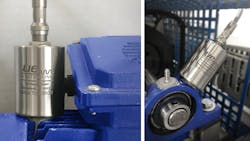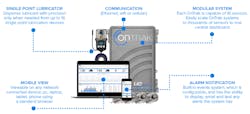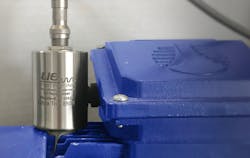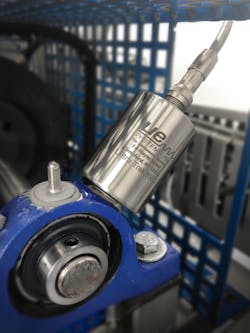What to Expect From Ultrasonic Inspection
At a Glance:
- Ultrasound inspection is a non-destructive testing method that detects electrical emissions and mechanical conditions in equipment.
- Predictive and proactive inspection of rotating equipment is becoming simpler with remote and online monitoring and quality control solutions.
- It is conceivable that remote monitoring technology may one day eclipse in-person testing methods. Until then, these technologies go hand-in-hand, said Sean Miller, Canadian Operations Manager at UE Systems.
When the design integrity of equipment is in question, so is the reliability of the equipment.
This statement might have been made by either a reliability engineer or a mechanical integrity engineer. After all, both engineering disciplines take design and installation principles seriously and use this knowledge to perform detailed analysis of how design and operating conditions will serve to minimize risk exposure.
The engineers might also add that just because a machine works, it does not mean that parts of the machine have not already started to fail. And by extension, an undetected flaw, a crack or a quality issue may pose challenges to the upkeep of the equipment throughout the lifecycle of the asset.
Non-destructive testing (NDT) methods, such as ultrasonic testing, are designed precisely to test asset integrity and find flaws before they occur. Ultrasonic testing and ultrasound data analysis are the enabling technologies that detect anomalies and even extend time before failure. That could be during the design phase or at the point where spares are stored or even at installation, said Sean Miller, Canadian Operations Manager at UE Systems, a manufacturer of ultrasonic instruments and training solutions provider with headquarters in Elmsford, N.Y.
Ultrasonic testing is commonly integrated with preventive maintenance strategies. The method of inspection is widely employed across industries to evaluate the properties of material, components and structures for quality, anomalies or potential flaws without damaging the part. The aircraft industry uses it to look for wear and internal anomalies in the airplane. The railroad industry uses it to examine rails for signs of damage. In industrial manufacturing, components such as bearings, pumps, compressors, pipes and tubes can be inspected for signs of wear-and-tear.
Ultrasonic testing uses high frequency sound waves to measure the internal structure of a component. The testing may take place at any stage of product development and throughout the lifecycle of equipment—from design and installation to potential failure and actual failure of equipment.
The lifecycle of a bearing is a convenient way to describe the efficacy of ultrasound testing, said Miller, who has taught and sold ultrasonic technology throughout Canada for the past 15 years. He advises students to consider two questions about bearing integrity when ascertaining whether the bearing’s lifecycle has diminished: How do we know that the bearing is “good” when we install it? And, how do we know if the asset or bearing has been lubricated properly?
Look at the bearing’s P-F curve to understand how ultrasonic digital instrumentation supports precision maintenance, said Miller. A P-F curve is a graph that looks at the health of an asset and measures potential failure and functional failure of the component based on historical data, or the moment where failure is first detected. A “good” bearing, according to Miller, is one that has no defects when it arrives from the OEM or hasn’t been on the part shelf for years without being maintained.
Ultrasound excels in determining whether the bearing is fit for purpose, because it is a way to determine that the bearing history may not have been recorded properly from the start and that it hasn’t been lubricated properly, said Miller. “That’s going to affect the life of that bearing, as we also know that the biggest failure mode in terms of bearings defects is improper lubrication,” he noted.
Ultrasound 101
UE Systems focuses on airborne and structure-borne ultrasound, said Miller. It is a predictive maintenance tool, he said, which provides a method for detecting leaks (compressed air or compressed gas leaks), electrical inspection (including corona tracking and arcing from energized equipment), bearing condition monitoring and lubrication, and steam trap and valve testing. Alongside recent advancements in software, motion control and robotics, a range of ultrasonic inspection instruments are available for industrial environment applications.
Ultrasonic testing is good for measuring friction, impact and turbulence. Airborne and structure-borne ultrasound uses the air or a structure to listen to the condition of an asset. In essence, high frequency sound waves are used to characterize or map the thickness or internal structure of an asset. The frequency or pitch used in ultrasonic testing far exceeds the limits of human hearing, and can range from 500 KHz to 20 MHz.
An ultrasound transducer connected to a diagnostic machine is waved over the asset being inspected. A couplant such as oil may also be used to separate the transducer from the asset. The transducer sends a pulse through the object. The sound or echo is sent back to the device once it hits an interface, such as the back wall of the asset. The results are translated to a diagnostic machine and are displayed by an amplitude representing the strength of the reflection as well as the distance, which is derived from the arrival time of the reflection. The presence of imperfections is based on the amount of sound reflected.
Upgrade to Industry 4.0
Non-destructive ultrasonic tools have come a long way since their rudimentary handheld counterparts. The rapid expansion of the Industrial Internet of things (IIoT) has propelled this shift. At UE Systems, the COVID-19 pandemic has further affected a demand for condition monitoring methods that include remote monitoring, noted Miller.
“With COVID-19 and with the lockdowns, we started to see a bigger shift into remote monitoring,” said Miller. “That’s especially the case with our newer systems, where a cloud-based system can monitor the bearing wear effectively, but also have a single-point lubricator attached.” Technicians now receive notifications on their mobile phones alerting them that a bearing needs lubrication. And with the click of a button, they’re able to lubricate the bearing from anywhere.
The uptake of online solutions that make use of a single-point lubricator or remote sensor to communicate with cloud-based software is primed for growth because it enables accountability, Miller said. Add to that growth the applicability and potential uses for artificial intelligence (AI), especially for repetitive ultrasound tasks.
In an autoclave case study, UE Systems worked with an industry partner to deploy its technology, Miller recalled. The objective was to learn what the machine was doing and how its algorithms were supposed to function. The same sensor technology, said Miller, is now being developed to help set baselines, which will then produce analytics, provide insights and inform corrective actions, such as when a bearing needs lubrication or when a defect has been identified.
That a lot of data is required in order to use ultrasound in AI implementations is a misconception, pointed out Miller. This is due to the simplicity with which one can diagnose the health of a bearing. An ultrasound analysis will demonstrate the health of a bearing based on the sound of the bearing.
“Firstly, a rolling element bearing will have the same characteristics whether it is a large bearing or small bearing, a low-speed or high-speed bearing,” explained Miller. “Secondly, historical trending is used,” he said. In other words, the frequency can be tested periodically to test the bearings and develop a trend. As that trend develops, technicians may set alarms to appropriate levels and take action.
Setting the baseline is simple—it is marked by setting the first reading. The majority of the time, said Miller, engineers will find their bearings are good and, if they are attuned to it and the sound is off, they can take corrective course immediately. Ultrasonic instruments can record sounds and allow engineers to do spectral analysis, which indicate such defects as harmonics, inner-race, outer-race, ball pass frequencies and misalignment.
Thirdly, Miller said, comparison methods (comparing the sound of one bearing against that of another) may also be used to understand the health of a bearing.
Ultrasound Online Training
One other advantage of remote monitoring is the ability to work online by offering technical support online (as opposed to in-person) and developing online training. Lockdowns forced companies like UE Systems to accelerate online training course development, and Miller has found that it allows a broader spectrum of students to take UE System’s certification courses. “The big impact of COVID-19 has to do with the ‘manpower’ issue,” said Miller. “Everyone is understaffed right now, and it doesn’t matter what industry you’re in.”
Among the hurdles facing facilities is the task of finding staff who have the skills to do ultrasonic testing, so remote monitoring helps the situation, said Miller. Training sessions that were ordinarily held in person have been shifted online. “We were already developing online-blended courses for our Level I and Level II, and the pandemic gave us the extra push to get it out there,” Miller said, adding that he has observed an increase in the uptake of online/blended courses and a decline in interest for in-person training.
What is not likely to change anytime soon is that industry will continue to rely on preventive maintenance and will continue to collect data using handheld instruments. “You’re still going to have that individual who is going to be championing or working with ultrasound or any other predictive technologies or condition-based monitoring technologies to be there for analysis,” contended Miller.
“We work off two resolutions: the equipment resolution and the spectral resolution. That’s the human element and it’s never going to go away.”
This article appeared in Power & Motion.
About the Author

Rehana Begg
Editor-in-Chief, Machine Design
As Machine Design’s content lead, Rehana Begg is tasked with elevating the voice of the design and multi-disciplinary engineer in the face of digital transformation and engineering innovation. Begg has more than 24 years of editorial experience and has spent the past decade in the trenches of industrial manufacturing, focusing on new technologies, manufacturing innovation and business. Her B2B career has taken her from corporate boardrooms to plant floors and underground mining stopes, covering everything from automation & IIoT, robotics, mechanical design and additive manufacturing to plant operations, maintenance, reliability and continuous improvement. Begg holds an MBA, a Master of Journalism degree, and a BA (Hons.) in Political Science. She is committed to lifelong learning and feeds her passion for innovation in publishing, transparent science and clear communication by attending relevant conferences and seminars/workshops.
Follow Rehana Begg via the following social media handles:
X: @rehanabegg
LinkedIn: @rehanabegg and @MachineDesign



